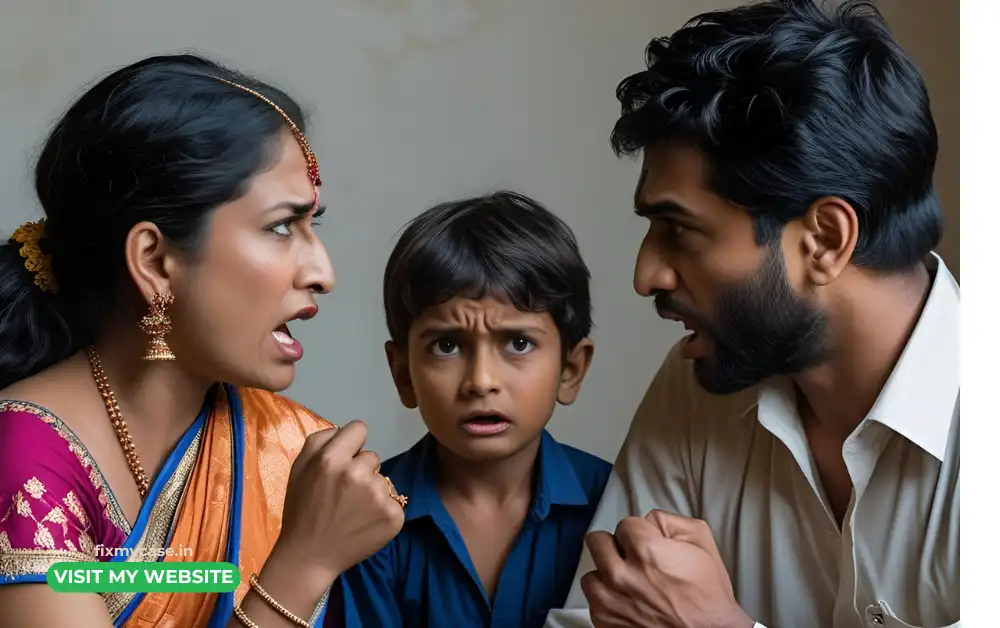
பெற்றோரின் விவாகரத்து ஒரு குழந்தையை எவ்வாறு பாதிக்கிறது என்பது அவர்களின் வயது, ஆளுமை மற்றும் விவாகரத்தின் சூழ்நிலைகளைப் பொறுத்தது. விவாகரத்து குடும்ப வாழ்க்கையில் உணர்ச்சிபூர்வமான விளைவுகளை ஏற்படுத்தக்கூடும், மேலும் அது குழந்தைகளின் வாழ்க்கையில் மாற்றத்தை ஏற்படுத்தும். இது குழந்தைகளை எவ்வாறு பாதிக்கும் என்பதற்கான சுருக்கமான விளக்கம் இங்கே.
விவாகரத்துக்குப் பிறகு குழந்தைகள் ஏற்படும் உணர்ச்சி வேறுபாடுகள் மற்றும் விளைவுகள்:
- மன அழுத்தம் மற்றும் குழப்பம்: பெற்றோர்களுக்கிடையே ஏற்படும் மோதல்கள் மற்றும் அவர்களுக்கு இடையே ஏற்படும் விவாகரத்து நடவடிக்கைகள் காரணமாக குழந்தைகள் மன அழுத்தம் மற்றும் குழப்பத்திற்கு ஆளாகிறார்கள்.
- சோகம் அல்லது துக்கம்: விவாகரத்து காரணமாக பெற்றோர் பிரிந்து செல்லும்போது, அது குழந்தைகளுக்கு மிகப்பெரிய இழப்பாகத் தோன்றலாம், இதனால் அவர்கள் சோகம் மற்றும் மனச்சோர்வு நிலையில் வாழ நேரிடும்.
- பதட்டம் அல்லது பயம்: விவாகரத்துக்குப் பிறகு குழந்தைகளின் எதிர்கால வாழ்க்கை நிலைமைகளில் ஏற்படும் மாற்றம் அவர்களின் வாழ்க்கையில் பய உணர்வை உருவாக்கலாம். பெற்றோரிடமிருந்து பிரிக்கப்பட்ட குழந்தைகள் பாதுகாப்பான சூழலில் பாதுகாப்பாக உணராமல் போகலாம், இது அவர்களை பதட்டமாக இருக்க அதிக வாய்ப்புள்ளது.
- கோபம்: விவாகரத்துக்குப் பிறகு, குழந்தைகள் வளரும்போது தங்கள் வாழ்க்கையில் ஒரு புதிய தந்தை அல்லது தாயைப் பெறுவதில் அவர்கள் வசதியாக இல்லாமல் இருக்கலாம், இது அவர்கள் கோபப்படுவதற்கும் வாழ்க்கையை வெறுப்பதற்கும் வழிவகுக்கும்.
விவாகரத்துக்குப் பிறகு குழந்தைகளின் நடத்தையில் ஏற்படும் மாற்றங்கள் மற்றும் விளைவுகள்:
- நடத்தையில் மாற்றங்கள்: விவாகரத்துக்குப் பிறகு, வாழ்க்கையில் ஏற்படும் மாற்றத்தைப் பற்றி தங்கள் மனதை மாற்றத் தயாராக இல்லாதபோது குழந்தைகள் தங்கள் நடத்தையை மாற்றிக்கொள்ள அதிக வாய்ப்புள்ளது. அவர்கள் பெரியவர்களிடம் மோசமாக நடந்து கொள்ளவும், பெரியவர்களிடமிருந்து தங்களைத் தனிமைப்படுத்திக் கொள்ளவும் அதிக வாய்ப்புள்ளது.
- கல்விச் சவால்கள்: விவாகரத்துக்குப் பிறகு குழந்தைகளில் ஏற்படக்கூடிய மன அழுத்தத்தால் குழந்தைகள் பாதிக்கப்படலாம், இதன் விளைவாக பள்ளியில் கவனம் மற்றும் செயல்திறன் குறையும்.
- எதிர்ப்பு அல்லது தவறான நடத்தை: டீனேஜர்கள் ஆபத்தான அல்லது முரண்பாடான நடத்தை மூலம் தங்கள் துயரத்தை வெளிப்படுத்தலாம்.
விவாகரத்துக்குப் பிறகு குழந்தைகளுக்கு சமூகத்தில் ஏற்படும் விளைவுகள்:
- உறவுப் போராட்டங்கள்: விவாகரத்துக்குப் பிறகு குழந்தைகள் நம்பிக்கை மற்றும் உறவுகளில் சவால்களை எதிர்கொள்ளக்கூடும், மேலும் புதிய உறவுகளை உருவாக்குவதில் சிரமம் ஏற்படலாம்.
- விசுவாசங்களை மாற்றுதல்: “யாருடைய பக்கம்” என்பதை “தேர்வு” செய்ய அழுத்தம் ஏற்படும் இது ஒரு பெற்றோருடனோ அல்லது இருவருடனும் உள்ள உறவுகளைப் பாதிக்கலாம்.
பெற்றோரின் பிரச்சனைகளால் குழந்தைகளைப் பாதிக்கும் காரணிகள்:
- பெற்றோர் மோதல்: பெற்றோர் மோதல்களால் குழந்தைகளின் மனநிலை பாதிக்கப்படுகிறது. கணவன் மனைவி இடையே ஏற்படக்கூடிய பிரச்சினைகள் காரணமாக குழந்தைகள் வாழ்க்கையில் பாதுகாப்பாக உணர முடியாது.
- பெற்றோரின் தரம்: ஒற்றுமை இல்லாத பெற்றோர்கள் தங்கள் குழந்தைகளின் வாழ்க்கையில் மன முன்னேற்றத்தை ஏற்படுத்த முடியாது. எப்போதும் சண்டையிடும் பெற்றோர்கள் ஒரு குழந்தைக்கு தரமான பெற்றோராக இருக்க முடியாது.
- நிலைத்தன்மை: பெற்றோரின் விவாகரத்தால் பிரிக்கப்பட்ட குழந்தைகள் நிலையான வாழ்க்கைச் சூழலில் வாழ முடியாது. பள்ளி மற்றும் நண்பர்களிடமிருந்து பிரிக்கப்பட்ட சூழ்நிலை அவர்களின் மனநிலையில் பெரும் தாக்கத்தை ஏற்படுத்தும்.
- குழந்தையின் வயது: சிறு குழந்தைகள் விவாகரத்தைப் புரிந்துகொள்வதில் சிரமப்படலாம், அந்த நேரத்தில் பெரியவர்கள் அதை வித்தியாசமாகச் செயல்படுத்தலாம்.
விவாகரத்துக்குப் பிறகு குழந்தைகளுக்கு ஏற்படும் நேர்மறையான விளைவுகள்.
சவாலானதாக இருந்தாலும், விவாகரத்து சில சமயங்களில் குழந்தையின் சூழலை மேம்படுத்தலாம், அதிக மோதல் அல்லது துஷ்பிரயோக சூழ்நிலையிலிருந்து அவர்களை விடுவிக்கலாம். காலப்போக்கில், சரியான ஆதரவுடன், பல குழந்தைகள் நன்கு தகவமைத்துக் கொண்டு, மீள்தன்மையை வளர்த்துக் கொள்கிறார்கள். துன்புறுத்தல் செய்யும் பெற்றோரிடம்மிருந்து தப்பித்து அவர்கள் எதிர்கால வாழ்க்கையை நல்ல பெற்றோர்களால் நலமுடன் வாழ முடியும்.
குழந்தைகள் வளர்ப்பில் விவாகரத்திற்கு பின் பெற்றோரின் பங்கு.
எதிர்மறை விளைவுகளை குறைக்க:
- திறந்த தொடர்பை வளர்த்துக் கொள்ளுங்கள், குழந்தைகளுடன் வெளிப்படையாக அன்பாக பேசுங்கள் அவர்களுக்கு என தேவை என்பதை புரிந்துகொள்ளுங்கள்,விவாகரத்து அவர்களின் தவறு அல்ல என்பதை குழந்தைக்கு உறுதியளிக்கவும்.
- பெற்றோர்கள் சண்டைகளுக்கு நடுவில் அவர்களை வைக்காதீர்கள்.பெற்றோர்களின் சண்டை அவர்கள் மன சோர்வடைய வைக்கலாம்.
- பெற்றோர்கள் தனித்தனியாக வாழ்ந்தால் இரு வீடுகளிலும் நிலையான மற்றும் வளர்ப்பு சூழலை உருவாக்குங்கள்.
- குழந்தை நீண்ட காலமாக மனச்சோர்வின் அறிகுறிகளைக் காட்டினால் தொழில்முறை உதவியை நாடுங்கள்,ஒரு குழந்தைகள் மனநல மருத்துவரை அணுகுங்கள்.
ஒவ்வொரு குழந்தையும் வித்தியாசமாக நடந்துகொள்கிறது, எனவே அவர்களின் தேவைகளுக்கு கவனம் செலுத்துங்கள் அன்பாக நடந்துகொள்ளுங்கள் பெற்றோர்களின் பிரிவு அவர்களை பாதிக்காமல் குழந்தைகளின் பெற்றோர்கள் பார்த்துக்கொள்ள வேண்டும்.
